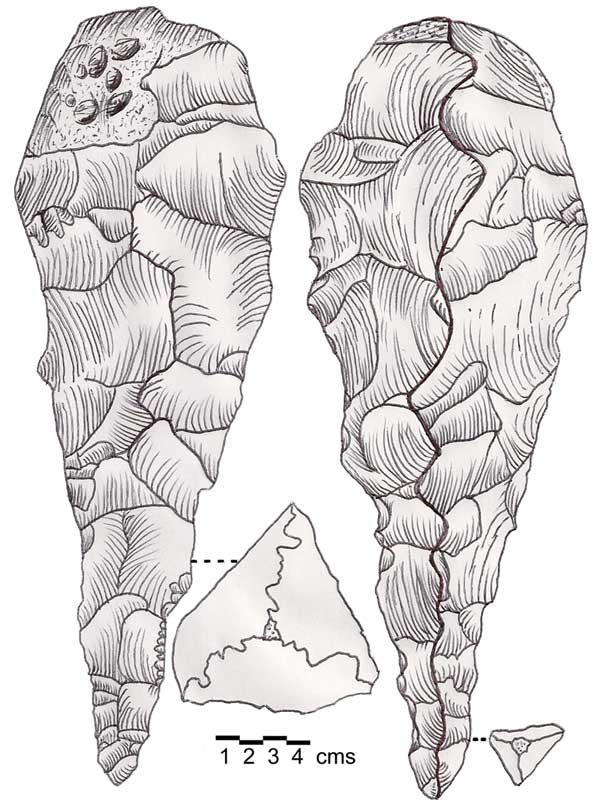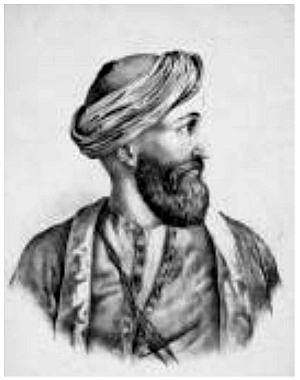|
Bachir Chehab II
Emir Bashir Shihab II () (also spelled "Bachir Chehab II"; 2 January 1767–1850) was a Lebanese emir who ruled Ottoman Lebanon in the first half of the 19th century. Born to a branch of the Shihab family which had converted from Sunni Islam, the religion of previous Shihabi Emirs, he was the only Maronite ruler of the Emirate of Mount Lebanon. Early life and family Bashir was born in 1767 in Ghazir,Salibi 1992, p. 58. a village in the Keserwan region of Mount Lebanon. He was the son of Qasim ibn Umar ibn Haydar ibn Husayn Shihab of the Shihab dynasty,Farah 2000, p. 766. which had been elected to the super tax farm of Mount Lebanon by other Druze nobility, also known as the Mount Lebanon Emirate, when their Druze kinsmen, the Ma'an dynasty died heirless in 1697. Although the Shihab family was ostensibly Sunni Muslim, some members of the family had converted to the Maronite Catholic Church. Bashir was among the first members of his extended family to be born a Christian.Khair ... [...More Info...] [...Related Items...] OR: [Wikipedia] [Google] [Baidu] |
Mount Lebanon Emirate
The Emirate of Mount Lebanon () was a part of Mount Lebanon that enjoyed variable degrees of partial autonomy under the stable suzerainty of the Ottoman Empire between the mid-16th and the early-19th century. The town of Baakleen was the seat of local power during the Ma'an period until Fakhr-al-Din II chose to live in Deir el Qamar due to a water shortage in Baakleen. Deir el Qamar remained the seat until Bashir Shihab II ascended to the throne and moved its court to the Beiteddine palace. Beiteddine remains the capital of the Chouf District today. Fakhr-al-Din II, the most prominent Druze tribal leader at the end of the 16th century, was given leeway by the Ottomans to subdue other provincial leaderships in Ottoman Syria on their behalf, and was himself subdued in the end, to make way for a firmer control by the Ottoman central administration over the Syrian eyalets. In Lebanese nationalist narratives, he is celebrated as establishing a sort of Druzes–Maronite condominiu ... [...More Info...] [...Related Items...] OR: [Wikipedia] [Google] [Baidu] |
Sunni Muslim
Sunni Islam () is the largest branch of Islam, followed by 85–90% of the world's Muslims. Its name comes from the word '' Sunnah'', referring to the tradition of Muhammad. The differences between Sunni and Shia Muslims arose from a disagreement over the succession to Muhammad and subsequently acquired broader political significance, as well as theological and juridical dimensions. According to Sunni traditions, Muhammad left no successor and the participants of the Saqifah event appointed Abu Bakr as the next-in-line (the first caliph). This contrasts with the Shia view, which holds that Muhammad appointed his son-in-law and cousin Ali ibn Abi Talib as his successor. The adherents of Sunni Islam are referred to in Arabic as ("the people of the Sunnah and the community") or for short. In English, its doctrines and practices are sometimes called ''Sunnism'', while adherents are known as Sunni Muslims, Sunnis, Sunnites and Ahlus Sunnah. Sunni Islam is sometimes referred ... [...More Info...] [...Related Items...] OR: [Wikipedia] [Google] [Baidu] |
Tripoli, Lebanon
Tripoli ( ar, طرابلس/ ALA-LC: ''Ṭarābulus'', Lebanese Arabic: ''Ṭrablus'') is the largest city in northern Lebanon and the second-largest city in the country. Situated north of the capital Beirut, it is the capital of the North Governorate and the Tripoli District. Tripoli overlooks the eastern Mediterranean Sea, and it is the northernmost seaport in Lebanon. It holds a string of four small islands offshore. The Palm Islands were declared a protected area because of their status of haven for endangered loggerhead turtles (''Chelona mydas''), rare monk seals and migratory birds. Tripoli borders the city of El Mina, the port of the Tripoli District, which it is geographically conjoined with to form the greater Tripoli conurbation. The history of Tripoli dates back at least to the 14th century BCE. The city is well known for containing the Mansouri Great Mosque and the largest Crusader fortress in Lebanon, the Citadel of Raymond de Saint-Gilles. It has the second ... [...More Info...] [...Related Items...] OR: [Wikipedia] [Google] [Baidu] |
Joub Jannine
Joub Jannine ( / ALA-LC: ''Jub Jannīn'') is located in the Beqaa Valley in Lebanon. Joub Jannine is the capital of West Beqaa. It is a town and the center of the Western Beqaa District, hosting the Serail, which is a main governmental building serving the area. Joub Jannine is the largest and most populated town in its district with a population of 14,728. All major banks exist in Joub Jannine as well as a trades college, Amusement Park, indoor/outdoor soccer arena, basketball court and the weekly Souk which takes place every Saturday and is a local produce market. Joub Jannine is surrounded by a number of villages. To the south there is the village of Lala, Ghazze to the north, Kamid al lawz to the east, and Kefraya, known for its wine grape vineyards, to the west. History In 1838, Eli Smith noted ''Jubb Jenin'' as a Sunni Muslim village in the Beqaa Valley. Archaeological sites Joub Jannine I is a small surface site brought to the surface through erosional activity of a s ... [...More Info...] [...Related Items...] OR: [Wikipedia] [Google] [Baidu] |
Jazzar Pasha
Ahmad Pasha al-Jazzar ( ar, أحمد باشا الجزّار; ota, جزّار أحمد پاشا; ca. 1720–30s7 May 1804) was the Acre-based Ottoman governor of Sidon Eyalet from 1776 until his death in 1804 and the simultaneous governor of Damascus Eyalet in 1785–1786, 1790–1795, 1798–1799, and 1803–1804. A Bosniak of obscure origins, he began his military career in Egypt in the service of various mamluk officials, eventually becoming a chief enforcer and assassin for Ali Bey al-Kabir, Egypt's practical ruler. He gained the epithet of ''al-Jazzar'' (the Butcher) for his deadly ambush on a group of Bedouin tribesmen in retaliation for the death of his master in a Bedouin raid. Al-Jazzar fell out with Ali Bey in 1768 after refusing to take part in the assassination of one of his former masters. He ultimately fled to Syria, where he was tasked with defending Beirut from a joint assault by the Russian Navy and Zahir al-Umar, the Acre-based ruler of northern Palestine. H ... [...More Info...] [...Related Items...] OR: [Wikipedia] [Google] [Baidu] |
Salima, Lebanon
Salima ( ar, صَلِيمَا; also spelled ''Salimeh'') is a municipality in the Baabda District of Mount Lebanon Governorate, Lebanon Lebanon ( , ar, لُبْنَان, translit=lubnān, ), officially the Republic of Lebanon () or the Lebanese Republic, is a country in Western Asia. It is located between Syria to the north and east and Israel to the south, while Cyprus lie .... There is one public school in the village with 130 students as of 2006. References {{Baabda District Populated places in Baabda District Druze communities in Lebanon ... [...More Info...] [...Related Items...] OR: [Wikipedia] [Google] [Baidu] |
Circassians
The Circassians (also referred to as Cherkess or Adyghe; Adyghe and Kabardian: Адыгэхэр, romanized: ''Adıgəxər'') are an indigenous Northwest Caucasian ethnic group and nation native to the historical country-region of Circassia in the North Caucasus. As a consequence of the Circassian genocide, which was perpetrated by the Russian Empire in the 19th century during the Russo-Circassian War, most Circassians were exiled from their homeland in Circassia to modern-day Turkey and the rest of the Middle East, where the majority of them are concentrated today. The Unrepresented Nations and Peoples Organization estimated in the early 1990s that there are as many as 3.7 million Circassians in diaspora in over 50 countries. The Circassian language is the ancestral language of the Circassian people, and Islam has been the dominant religion among them since the 17th century. Circassia has been subject to repeated invasions since ancient times; its isolated terrain couple ... [...More Info...] [...Related Items...] OR: [Wikipedia] [Google] [Baidu] |
Sidon
Sidon ( ; he, צִידוֹן, ''Ṣīḏōn'') known locally as Sayda or Saida ( ar, صيدا ''Ṣaydā''), is the third-largest city in Lebanon. It is located in the South Governorate, of which it is the capital, on the Mediterranean coast. Tyre to the south and Lebanese capital Beirut to the north are both about away. Sidon has a population of about 80,000 within city limits, while its metropolitan area has more than a quarter-million inhabitants. Name The Phoenician name ''Ṣīdūn'' (, ) probably meant "fishery" or "fishing town". It is mentioned in Papyrus Anastasi I as Djedouna. It appears in Biblical Hebrew as ''Ṣīḏōn'' ( he, צִידוֹן) and in Syriac as ''Ṣidon'' (). This was Hellenised as ''Sidṓn'' ( grc-gre, Σιδών), which was Latinised as '. The name appears in Classical Arabic as ''Ṣaydūn'' () and in Modern Arabic as ''Ṣaydā'' (). As a Roman colony, it was notionally refounded and given the formal name ' to honour its imper ... [...More Info...] [...Related Items...] OR: [Wikipedia] [Google] [Baidu] |
Kfar Nabrakh
Kfar Nabrakh ( ar, كفر نبرخ ''Kfar Nabrakh'') is a municipality in the Chouf District of Mount Lebanon Governorate, Lebanon. It is located 50 kilometers southeast of Beirut. Kfarnabrakh total land area consists of 941 hectares. Its average elevation is 1,010 meters above sea level. Its inhabitants are religiously mixed, with a Druze majority and a Melkite Christian minority. During the Lebanese Civil War The Lebanese Civil War ( ar, الحرب الأهلية اللبنانية, translit=Al-Ḥarb al-Ahliyyah al-Libnāniyyah) was a multifaceted armed conflict that took place from 1975 to 1990. It resulted in an estimated 120,000 fatalities a ..., 64 residents of the village were killed in the violence. References Populated places in Chouf District Melkite Christian communities in Lebanon Druze communities in Lebanon {{Lebanon-geo-stub ... [...More Info...] [...Related Items...] OR: [Wikipedia] [Google] [Baidu] |
Arabic
Arabic (, ' ; , ' or ) is a Semitic language spoken primarily across the Arab world.Semitic languages: an international handbook / edited by Stefan Weninger; in collaboration with Geoffrey Khan, Michael P. Streck, Janet C. E.Watson; Walter de Gruyter GmbH & Co. KG, Berlin/Boston, 2011. Having emerged in the 1st century, it is named after the Arab people; the term "Arab" was initially used to describe those living in the Arabian Peninsula, as perceived by geographers from ancient Greece. Since the 7th century, Arabic has been characterized by diglossia, with an opposition between a standard prestige language—i.e., Literary Arabic: Modern Standard Arabic (MSA) or Classical Arabic—and diverse vernacular varieties, which serve as mother tongues. Colloquial dialects vary significantly from MSA, impeding mutual intelligibility. MSA is only acquired through formal education and is not spoken natively. It is the language of literature, official documents, and formal writ ... [...More Info...] [...Related Items...] OR: [Wikipedia] [Google] [Baidu] |
Hasbaya
Hasbeya or Hasbeiya ( ar, حاصبيا) is a town in Lebanon, situated at the foot of Mount Hermon, overlooking a deep amphitheatre from which a brook flows to the Hasbani. In 1911, the population was about 5000. Hasbaya is the capital of the Wadi El Taym, a long fertile valley running parallel to the western foot of Mount Hermon. Watered by the Hasbani river, the low hills of Wadi El Taym are covered with rows of silver-green olive trees, its most important source of income. Villagers also produce honey, grapes, figs, prickly pears, pine nuts and other fruit. Mount Hermon, 2745 metres high, is a unifying presence throughout the Wadi El Taym. This imposing mountain held great religious significance for the Canaanites and Phoenicians, who called it the seat of the All High. The Romans, recognising it as a holy site, built many temples on its slopes. Some identify Hasbaya with the Old Testament's "Baal – Hermon," while in the New Testament the mountain is the site of the transfig ... [...More Info...] [...Related Items...] OR: [Wikipedia] [Google] [Baidu] |








